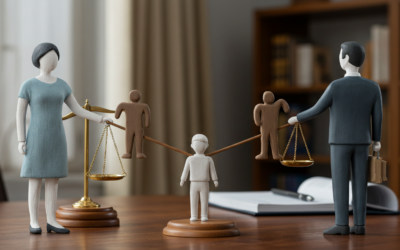Think divorce has to be a battle? Think again! While many people picture divorce as a drawn-out court drama, there’s actually a simpler way. It’s called uncontested divorce. And in Wisconsin, it might be exactly what you’re looking for.
In this guide, we’ll walk you through everything you need to know about uncontested divorce in Wisconsin. We’ll explain what it is, what you need to qualify, and how the process works. You’ll discover why many couples choose this path for a less stressful and more affordable separation.
Disclaimer: This article provides general information about uncontested divorce in Wisconsin. It’s not legal advice. For guidance specific to your situation, you should consult with a qualified attorney.
What is an Uncontested Divorce?
The name says it all! An uncontested divorce happens when both spouses agree on all major issues in their divorce. But what exactly does “all major issues” mean? Let’s look at what Wisconsin law requires couples to address:
- Property Division: How you’ll split your assets and debts
- Child Custody and Placement: Where the children will live and how you’ll make decisions about their care
- Child Support: How you’ll financially support your children
- Spousal Maintenance: Whether one spouse will provide financial support to the other
- Other Issues: Like name changes or insurance coverage
Agreement is absolutely essential here. Even one small disagreement can turn your uncontested divorce into a contested one. Here’s the key difference: In a contested divorce, you need the court to step in and make decisions. In an uncontested divorce, you and your spouse make all the decisions together.
In Wisconsin, most uncontested divorces start with a “Joint Petition.” This means both spouses sign the initial paperwork together, showing the court you’re on the same page from day one.
Requirements for an Uncontested Divorce in Wisconsin
Before you jump into the process, you’ll need to make sure you meet Wisconsin’s requirements. The state has specific rules about who can file for divorce and when.
- Residency Requirement: At least one spouse must live in Wisconsin for six months and in the county where you’re filing for 30 days before filing (Wis. Stat. § 767.301)
- Waiting Period: Wisconsin requires a 120-day cooling-off period after filing before finalizing your divorce (Wis. Stat. § 767.335)
- Complete Agreement: Both spouses must agree on ALL issues – property, debt, custody, support
- Legal Grounds: You both must agree the marriage is “irretrievably broken” (Wis. Stat. § 767.315)
The Uncontested Divorce Process in Wisconsin
You’ll be glad to know that, in most cases, an uncontested divorce is much less complicated and stressful than a contested one. While going through any divorce is tough, this process helps minimize the emotional toll on everyone involved.
Step 1: Initial Paperwork
The process starts with filing a Joint Petition for Divorce. You’ll need to complete several forms, including a Confidential Petition Addendum and Vital Statistics form. You can get these forms from the Wisconsin Court System website or your local county clerk’s office.
Step 2: Financial Disclosure
Next, you’ll both need to share complete financial information using a Financial Disclosure Statement. This step is crucial – be honest and thorough! The court takes financial disclosure seriously.
Step 3: Marital Settlement Agreement
This is where you put all your agreements in writing. Your Marital Settlement Agreement covers everything from who keeps the house to how you’ll handle holidays with the kids. While you can write this yourself, having a lawyer review it can save you from future headaches.
Step 4: Filing Documents
Take your completed paperwork to your county clerk’s office. You’ll need to pay a filing fee, but fee waivers are available if you can’t afford it.
Step 5: Waiting Period
Remember that 120-day waiting period we mentioned? This is where it comes in. Use this time to make sure you’re comfortable with all your decisions.
Step 6: Final Hearing
The last step is usually a brief court hearing. The judge will review your paperwork and ask some questions to make sure you understand and agree to everything. Some counties might even waive this hearing if your paperwork is perfect!
Advantages of Uncontested Divorce
The advantages of uncontested divorce might seem obvious at first glance. But let’s dig deeper into why this option often works so well:
- Lower Cost: You’ll spend much less on legal fees
- Faster Process: Most uncontested divorces wrap up much quicker than contested ones
- Less Stress: When you work together, there’s less conflict and emotional strain
- More Control: You decide your future, not a judge
- Better for Kids: Less fighting means less stress on your children
- Privacy: Fewer details become public record
When Uncontested Divorce May Not Be Appropriate
While we wish every divorce could be uncontested, sometimes it’s just not the right choice. Here’s when you might need to consider other options:
- Domestic Violence: If there’s any history of abuse, your safety comes first
- Complex Finances: High-value assets or complicated business interests might need more formal oversight
- Major Disagreements: Remember, you need to agree on everything
- Uncooperative Spouse: Both parties need to participate willingly
It’s natural to want to get through this process quickly. But don’t sacrifice what you deserve just to keep things simple.
Role of an Attorney in Uncontested Divorce
Who says uncontested divorce says no court battle. Yet and still, having an attorney by your side can be beneficial in many ways. While you’re not required to have a lawyer, their experience can be invaluable. They can review your agreement to make sure it’s fair, help with confusing paperwork, and answer your questions along the way.
Conclusion
Uncontested divorce offers a path to end your marriage with less stress, lower costs, and more control over the outcome. If you and your spouse can work together, this might be your best option for moving forward.
Ready to learn more about uncontested divorce in Wisconsin? Contact us to discuss whether this path might be right for you. Remember, while the process might be simpler, having experienced legal guidance can help ensure your rights are protected every step of the way.




